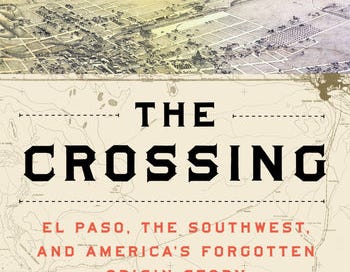"The Crossing" Book Review - Rediscovering America's Origins: Unveiling El Paso's Hidden Historical Role
Join Richard Parker as he shifts the narrative, focusing on the multicultural exchanges at America's true starting point.
😽 Keepin’ It Simple Summary for Younger Readers
👧🏾✊🏾👦🏾
🌎 America's history isn't just about people moving west from places like Plymouth Rock. 📚 Richard Parker explains how the real story started in the Southwest, where lots of different people and cultures came together, especially in El Paso, Texas. 🌵 This helps us understand the mix of cultures that has always been part of America's real story. 🤝
🗝️ Takeaways
🌎 Altered Origins: American history's beginnings are reframed from the East Coast to the Southwest, specifically El Paso.
🔄 Cultural Exchange: The book highlights the fractal nature of borderland history with recurring cultural dynamics.
🌐 Network Centrality: Describes El Paso as a pivotal cultural crossroads akin to a central node in network theory.
🚫 Violence of Borders: Examines historical and contemporary violence arising from imposed boundaries and rigid categories.
🏗 Reframe of Identity: Challenges and reconstructs the traditional narrative of Manifest Destiny through a multicultural lens.
📜 Rich History: Showcases the story of El Paso as a more significant immigrant integration hub than Ellis Island.
🕰 Lessons from the Past: Illuminates how understanding borderland history helps navigate modern identity and societal issues.
The Crossing: Rewriting America's Origin Story from the Borderlands
A Review of Richard Parker's "The Crossing: El Paso, the Southwest, and America's Forgotten Origin Story"
In the quiet corners of our library's Southwest collection, amid centuries-old maps and dusty chronicles, I've often traced my fingers along the ancient routes that crisscross the borderlands, wondering about the stories embedded in these well-worn paths. Richard Parker's "The Crossing" arrives like a revelation, giving voice to these silent trajectories and fundamentally challenging our understanding of American origins.
As a mathematician turned librarian, I'm drawn to patterns—the way numbers and stories reveal hidden truths when properly arranged.
Parker's work presents what mathematicians might call elegant proof: By shifting our historical origin point from East to West, from Plymouth Rock to El Paso, the entire equation of American history resolves itself with startling clarity.
Remapping American Origins
The book's central thesis is both simple and revolutionary: American history did not begin on the Atlantic seaboard but in the Southwest, specifically in El Paso—a natural crossing point of the Rio Grande that has served as a cultural confluence for millennia. Parker builds this argument with the precision of a master architect, laying one foundation upon another of historical evidence.
What makes this work particularly compelling is how it illuminates the fractal nature of borderland history. Like the recurring patterns in complex mathematical sets, we see similar dynamics of cultural exchange, resistance, and adaptation playing out across different scales of time and space.
The story of Esteban (or Estevanico), a Moroccan enslaved person who became "the first white man" seen by Indigenous peoples of the Rio Grande Valley, exemplifies the kind of categorical disruption that characterizes borderland histories.
A Mathematical Lens on Cultural Complexity
As someone who once dedicated years to studying topology, I am struck by how Parker's narrative reveals what we might call the "cultural topology" of the Southwest.
The region's geographic features—its mountain passes, river valleys, and desert corridors—have created natural pathways for human movement that transcend the artificial boundaries we've tried to impose on them.
The book depicts El Paso as a crucial hub within a vast cultural exchange network, echoing the idea of centrality in network theory—illustrating how specific nodes are vital for the entire system's operation.1
Parker demonstrates how El Paso's position at the intersection of North-South and East-West routes made it not just a geographical crossroads but a crucible for American multiculturalism.
The Violence of Artificial Boundaries
One of the most powerful aspects of Parker's work is his framing device: the 2019 Walmart massacre in El Paso. As someone who has spent years helping patrons navigate resources on social justice and civil rights, I find his connection between historical patterns of violence and contemporary manifestations of white supremacy both haunting and necessary.
The shooter's targeting of what he perceived as a "Mexican" invasion reveals the tragic irony at the core of borderland violence: the attempt to impose rigid categories and boundaries on a region characterized by fluidity and cultural synthesis.
Parker illustrates that this violence is not new; rather, it is a recurring pattern in the history of the Southwest, from the Spanish conquest to American expansion.
Beyond the Myths of Manifest Destiny
What Parker accomplishes here is nothing less than a complete reframing of American identity itself. By showing how El Paso served as a multicultural hub centuries before the concept of "diversity" entered our national conversation, he provides both historical precedent and a future blueprint for an increasingly pluralistic America.
The traditional narrative of Manifest Destiny—of civilization marching inevitably westward—crumbles when viewed from El Paso.
Instead, we see a complex web of civilizations, migrations, and cultural exchanges that defy simple directional narratives. Parker's work reveals how the Southwest has always been what America is becoming: a space where cultures meet, clash, and ultimately create something new.
A Personal Resonance
As I've watched patrons engage with our library's collections, I've observed how personal stories often provide the most powerful counter-narratives to simplified histories. Parker's work, while deeply researched and academically rigorous, never loses sight of the human dimension of borderland history.
His exploration of how El Paso processed more immigrants than Ellis Island challenges our national mythology about immigration while highlighting the ongoing relevance of borderland dynamics to contemporary American life.
The book demonstrates how the patterns of cultural exchange and adaptation that characterized early El Paso continue to shape American identity today.
Looking Forward Through the Past
What makes "The Crossing" particularly vital in our current moment is its vision of how understanding our true origins might help us navigate our future.
As our nation grapples with questions of identity, belonging, and the very nature of American society, Parker's work suggests that the answers might be found in the long history of borderland communities that have already navigated these challenges.
For those of us who work at the intersection of knowledge preservation and social justice, "The Crossing" provides both inspiration and instruction. It demonstrates how careful historical analysis can challenge dominant narratives while offering new frameworks for understanding both our past and our possible futures.
Conclusion
"The Crossing" is more than just a historical revision—it's a fundamental reconceptualization of American identity and origins. Like the best mathematical proofs, it achieves this through careful logic and attention to detail while arriving at conclusions that transform our understanding of the entire system.
For readers seeking to understand both America's past and its possible futures, "The Crossing" is an essential addition to their intellectual journey. It reminds us that the story of America isn't simply about East-to-West expansion; it's about the complex networks of cultural exchange, resistance, and adaptation that have always characterized our borderlands.
In these patterns of the past, we might find the key to our collective future.
In her notable work, “Almanac of the Dead,” Indigenous author Leslie Marmon-Silko employs a similar perspective towards Tucson, a city intimately connected to El Paso through their shared histories. This connection is particularly evident as they serve as a sunny coast-to-coast pathway that remains accessible year-round—unlike the snow-covered Rockies and Sierra Nevadas faced by the other transcontinental railroad each winter. Notably, when driving on the I-10 freeway in Tucson, the primary city destinations displayed are Phoenix to the west and El Paso to the east, continually reminding us of our brothers and sisters living nearby at the New Mexico-Texas border, where the Rio Grande meets Mexico.








This sounds like an excellent book.